2009 Toyota Landcruiser Prado Reviews
You'll find all our 2009 Toyota Landcruiser Prado reviews right here. 2009 Toyota Landcruiser Prado prices range from for the Landcruiser Prado to for the Landcruiser Prado Gxl 4x4.
Our reviews offer detailed analysis of the 's features, design, practicality, fuel consumption, engine and transmission, safety, ownership and what it's like to drive.
The most recent reviews sit up the top of the page, but if you're looking for an older model year or shopping for a used car, scroll down to find Toyota dating back as far as 1996.
Or, if you just want to read the latest news about the Toyota Landcruiser Prado, you'll find it all here.

Used Toyota Land Cruiser Prado review: 2003-2016
Read the article
By Ewan Kennedy · 20 Apr 2017
Toyota imports a large number of 4WD, SUV and crossover vehicles to Australia and dominates our market here.

Used Toyota Land Cruiser Prado review: 2009-2013
Read the article
By Graham Smith · 03 Jul 2015
Toyota largely built its enviable reputation for toughness and reliability on big, lusty four-wheel drives like the Prado. Regarded as the LandCruiser's little brother, the Prado is a big wagon that is able to cope with life in town. New It can accommodate up to seven in reasonable comfort, with some space left over
-W.jpg)
Used Toyota Land Cruiser Prado review: 2009-2012
Read the article
By Graham Smith · 23 Jan 2014
The fourth generation Landcruiser Prado brought new town-friendly refinement on a level never before dreamt of by fans of the popular mid-sized wagon.

Used Toyota Land Cruiser Prado review: 1996-2013
Read the article
By Ewan Kennedy · 28 Oct 2013
A sensible cross between a full-on 4WD and a passenger carrying SUV, the Toyota Prado is built by the Japanese company that’s now in its sixth decade in the off-road field in Australia.

Used Toyota Land Cruiser Prado review: 2003-2009
Read the article
By Graham Smith · 10 May 2012
Graham Smith reviews the 2003, 2004, 2005, 2006, 2007, 2008 and 2009 Toyota Landcruiser Prado as a used buy.
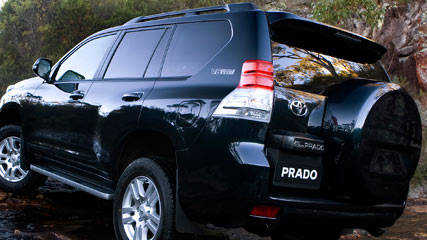
Best 4WD, AWD and SUV for seniors 2009 Review
Read the article
By Neil Dowling · 21 Dec 2009
Life - human and automotive - is so unpredictable. When my 75-year-old father went looking for a car to retire with, he sought reliability, durability, comfort and a long warranty. He bought a Hyundai, thinking that with a five-year warranty it should ‘see me out’.In fact, he saw it out. The Hyundai Lantra is still ultra-reliable in the hands of a mate of mine while my now 84-year-old father has moved himself and my active mother into the latest Corolla. I would have expected my parents to drive a Mercedes-Benz in later life as a reward for their tenacity through economic depressions and wars.In fact, they chose economy in reverence to their working-class lives and have come out with only minor financial scars from their post-retirement car purchases. You can as well. Carsguide readers with retirement looming all want new cars. Most of them want a 4WD or something powerful to tow a caravan or boat because ‘we're not dead yet’.It doesn't have to be expensive, but if you are retired or just on the point of pulling the pin on a working career, you want the least possible hassles. We'll start this week with 4WDs and SUVs. These are some choices. They clearly aren't all that is available and personal choice will play its role. At the very least, this should get you thinking.4WD is for the adventurer who actually wants to go off the beaten track. These have excellent towing ability, diesel engine options (the better choice), a versatile cabin with seven seats that can be removed when not wanted, good safety levels and a comprehensive feature list. On the downside, they are big, less comfortable than a sedan, require more expensive servicing and repair (especially tyre replacement) and for aged limbs can be difficult to get in and out.Toyota Prado (from $55,990)Solid, high resale (and high initial purchase), great off the road and in the latest model, comfortable on the road.Engine: 127kW/410Nm 3-litre 4-cyl turbo-dieselTransmission: 6-speed manual/5-speed auto/2-speed transferEconomy: 8.3 l/100kmSafety: 7 airbags, ESC, traction controlLand Rover Discovery-4 (from $81,990)Exceptionally competent and fitted out with excellent comfort. Fourth generation aims to rid Land Rover of quality bugs.Engine: 180kW/600Nm 3-litre V6 biturbo-dieselTransmission: 6-speed auto/2-speed transferEconomy: 9.3 l/100kmSafety: 8 airbags, ESC, traction controlMitsubishi Pajero(from $49,290)Great all-rounder on and off road at an affordable price. Better cabin package than Prado.Engine: 147kW/441Nm 3.2-litre 4-cyl turbo-dieselTransmission: 5-speed auto/2-speed transferEconomy: 8.4 l/100kmSafety: 2 airbags, ESC, traction controlSUV: Don't want to go to the Outback but like the practicality of a tall wagon? The SUV usually has all-wheel drive but less rugged construction and no low-range gearbox. Some are even only front-wheel drive so save on purchase price and fuel consumption.Hyundai Santa Fe (from $37,990)Practical, versatile and reliable with a long five-year warranty. A good allrounder. Only available as a diesel and with all-wheel drive.Engine: 145kW/421Nm 2.1-litre 4-cyl turbo-dieselTransmission: 5-speed manual/5-speed auto/AWDEconomy: 6.7 l/100kmSafety: 6 airbags, ESC, traction controlPeugeot 4007 (from $45,490)Culturally diverse Peugeot made by Mitsubishi (it's basically an Outlander shell) in Japan with an aggressive grille and very desirable turbo-diesel engine and optional six-speed auto.Engine: 115kW/380Nm 2.2-litre 4-cyl turbo-dieselTransmission: 6-speed manual/6-speed auto/AWDEconomy: 7.0 l/100kmSafety: 7 airbags, ESC, traction controlSubaru Outback diesel (from $40,490)Long-awaited diesel expands Subaru's out-of-town ability in a very desirable package. New style isn't the prettiest but is functional and roomy.Engine: 110kW/350Nm 2-litre 4-cyl turbo-dieselTransmission: 6-speed manual/AWDEconomy: 6.4 l/100kmSafety: 7 airbags, ESC, traction control
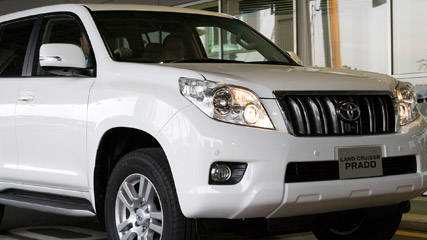
Toyota Land Cruiser Prado 2009 review
Read the article
By Karla Pincott · 22 Oct 2009
A toytown test track is not the best place to try out a big Toyota Prado, but the sampler at the Megaweb was all we had on offer. But while repeats runs on the mini circuit were never going to test the 4WD’s offroad ability, the tight corners, gentle slalom and a section of cobblestones did herald that the new vehicle is smoother and quieter.That’s no surprise, given the current model has set a pretty high baseline. After trying out the new push-button start too early (and being admonished by a light-stick wave from one of the track ‘guards’) we only had enough track length to punch the 203kW/380Nm 4.0-litre V6 up around 80km/h in short bursts of acceleration, with the five-speed sequential automatic slotted into the mock-manual mode.It sparked a wave of shocked faces on the Prado’s army of minders, who seemed more used to funseekers pootling around at 10km/h.But the engine’s eagerness – and guttural voice – were enough to promise it’ll be happy to be challenged. It steered seamlessly around the low-speed turns and hairpins. But even though we were taking them at perhaps a slightly higher notch than the suggested speed, it wasn’t enough to give a true indication of real-world driving.This third generation offers an updated cabin, with classier materials and accents, dominated by a massive and bluff-sided centre stack.The roofline has been lowered by just under 20mm, which perhaps makes it look a little sleeker – if you squint the right way. Our test car had the spare tyre mounted under the floor to accommodate a split rear gate, but the Aussie ones will retain the rear door and back-mounted wheel set-up of the outgoing model.Its maximum seating capacity has dropped from eight to seven, which may lose it a few buyers who prefer the big 4WD to settling for a more demure people mover. But you still climb high, and sit high, in the cabin.Given that the other vehicles on the test track ranged from sedans down to the miniature iQ, there was a clear sense of dominating the traffic, which will give the Prado a tick from those who want to venture into the wilds of shopping centres and school drop-off zones.
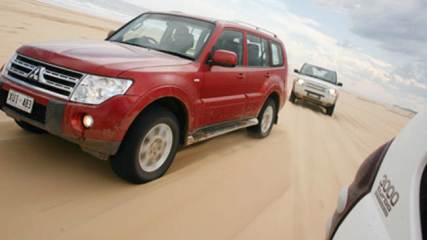
Mitsubishi Pajero vs Land Rover Discovery 3 vs Toyota Land Cruiser Prado 2009
Read the article
By Fraser Stronach · 30 Sep 2009
What you pay, what you get The GLS Pajero Di-D is the least expensive of our three contenders and in auto guise lists at $59,790. And for that money you get electronic traction and stability control and side and curtain airbags as standard. At $61,040 the Prado GXL D-4D automatic also has the latter mentioned items but misses out on the electronic driving aids and extra airbags although both are available as an option pack.The Discovery TDV6 S is a $67,590 ask. While the TDV6 S misses out on third-row seating that's standard on both Prado and Pajero it does come with the aforementioned height-adjustable air suspension, a 6-speed auto (the others both have 5-speeders), electronic traction and stability control, front, side and curtain airbags, cruise and climate control, and 17-inch alloys.Horses or ponies? All three contenders are common-rail turbo diesels but where the Prado and Pajero have 4-cylinder engines of 3.0 and 3.2-litres respectively, the Discovery is powered by a 2.7-litre V6. And, as mentioned above, the Disco has a 6-speed auto while the other two have 5-speeders. Both Disco and Pajero have 'manual' control via tip-shift functions whereas the Toyota's box has a dogleg-gated shift (no shift release) that gives good manual control once you learn the layout of the gate.For its part, the Pajero's winning performance is tarnished by the fact that the engine is noisier and less refined than the other two and its gearbox is not as decisive as it could be. In between is the Prado. For noise control and general running refinement it's a far better prospect than the Pajero but it's still not up to the high standard set by the Land Rover.A dynamic argument There are three different schools of thought on chassis design here. The Pajero is a monocoque design with fully independent suspension and, as such, is the most 'car' like. The Discovery also has fully independent suspension but is a separate-chassis design (admittedly a very sophisticated one) while the Prado is the most traditional vehicle here with live rear axle/independent front suspension, and a conventional separate chassis.And, on the road the Prado doesn't feel as sharp as the other two, but this is not just the fact that it lacks independent rear suspension. Toyota has deliberately opted for a soft suspension tune that puts comfort ahead of sharp dynamics. What's more, and perhaps this is deliberate as well, the Toyota will more readily understeer when pushed. Combine all this with the least accurate and direct steering of the three and the Toyota is far from a 'driver's' car although there is nothing actually 'wrong' with its handing.The other two are harder to separate with the Discovery having the advantage of height-adjustable suspension and slightly sharper steering than the Pajero. But ultimately, the Disco's weight plays against it and it lacks of agility of the Pajero, a fine handling 4WD by any standards.The downside of this is that the Pajero has the harshest and noisiest ride.The Discovery's ride is between the two. Interestingly, despite the fact that we have driven more Discovery 3s then we can remember, this must be one of the very few that we've driven on the standard-spec 235/70R17 tyres. And we are impressed. They are far more forgiving and comfortable than the lower profile hoops on the 18s more commonly fitted to the Discovery 3s driven previously.A muddy story All three vehicles here are more than handy off road and all are capable of performing off road feats.There's also an important question here of off road ability verses off road comfort, as the two don't necessarily go hand in hand.The most comfortable of the three off road (although not by a great margin) is the Toyota. Thanks to its soft springing and decent suspension travel it soaks up the bumps better than the other two. But, despite the on-paper advantage of its live rear axle, its lack of traction control sees it trail the field in terms of off road ability.Next up the ladder in terms of off road ability, but the poorest in terms of off road comfort by a good margin is the Pajero.Comfortably ahead of the Pajero, let alone the Prado in off road ability is the Discovery. Mind you, the Disco was fitted with the optional rear locker that we know from previous experience makes a considerable difference. But at just $1050, it hardly makes a difference to the overall cost of the vehicle and, unlike the Pajero where (manual) activation of the optional rear locker negates the traction control, with the Discovery the rear locker engages automatically and leaves the traction control active so it can take care of front axle control.Summing up Picking an absolute winner between Pajero and Prado is difficult to say the least although the Pajero does have more points in its favour. Compared to the Prado it's less expensive but still better equipped. It's also a stronger performer and handles better on road. It's also more capable off road, at least at this spec level where traction and stability control isn't standard. It also has a higher towing capacity.Taken alone you would think all that would be enough to seal the deal. But the Toyota is strong in some very important areas. Most significantly it's far more refined, quieter and more comfortable on road. It's also more comfortable off road. It also has a monster touring range, seats eight not seven and has a higher payload. The choice between Prado and Pajero can only come down to your personal priorities.As for the Discovery, in many ways it feels twice the vehicle the other two are, and not just something that's $8000 more expensive than the Pajero and only $4000 more expensive than a Prado optioned with the safety gear that's standard on the other two. The real killer with the Discovery is the cost of the third-row seats although this may not matter to you.What's not diminished however is the huge gap in technology between Discovery, and Prado and Pajero ... and what that technology advantage delivers.Read the full article, plus more great 4WD and off-roading news in the latest edition of Overlander magazine or visit overlander.com.au
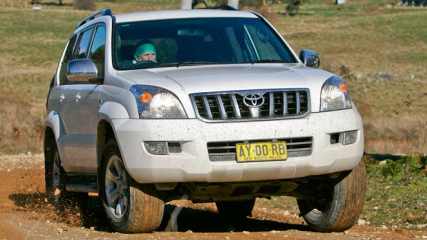
Prado vs Hilux 2009 Review
Read the article
By Fraser Stronach · 12 Aug 2009
People regularly ask us the question, should I buy a Prado or a dual-cab HiLux? … almost as often as the question what's the best, Prado or Pajero.Prado and HiLux are the biggest selling vehicles in their respective classes so it's not surprising that the wagon versus dual-cab ute question most often revolves around these two. For the purpose of this comparison exercise we have chosen the popular turbo-diesel models (in automatic guise) rather than the V6 petrols.SPEC TESTEDThe Prado is a mid-spec GXL model while the HiLux is a top spec SR5, the nearest equivalent to the Prado GXL in terms of equipment given that Toyota doesn't offer (not yet, anyway!) luxuries like leather, sat-nav or safety kit like electronic stability and traction control in a 'Lux.PRICINGAt these spec levels the Prado asks $61,040 (plus on-road costs) while the HiLux is $53,980. Add $2500 for a genuine Toyota or aftermarket canopy to bring the ute up to the storage functionality of the wagon and you are looking at a difference of less than $5000.One may be a ute and the other a wagon, but Prado and HiLux share much in common as far as suspension, safety and engines go. But there are differences, and important ones at that.SUSPENSIONThe HiLux's rear axle is sprung and located by traditional leaf springs while the Prado's rear axle is sprung via coils and located by four trailing arms and a Panhard rod.4WD SYSTEMSJust as significant is the fact that the HiLux uses old-school part-time 4WD while the Prado has full-time 4WD via a torque-sensing centre differential.ENGINESThe HiLux's engine is also in a lower state of tune than that of the Prado. While both make similar maximum power (126kW for the HiLux and 127kW for the Prado), the Prado has a higher maximum torque output (410Nm versus 343Nm). This extra torque translates to more power right through the rev range with the HiLux only coming close to matching the Prado in the higher reaches. The Prado also has the added advantage of a five-speed automatic while the HiLux has to make do with the four-speed auto that was used in the Prado before the five-speeder was introduced.With considerably more power just about everywhere and the benefit of its five-speed auto the Prado has the wood on the HiLux for performance. But the difference is not as much as you might think, as the HiLux is some 300kg lighter than the Prado.What's more noticeable than the actual performance difference is the fact that the Prado feels more relaxed and effortless than the HiLux, which seems to work harder to achieve less. Much of this comes down to the two gearboxes. The Prado's five-speeder is 'smarter' and more decisive than the HiLux's four-speeder and it shifts more quickly and more smoothly. For its part, the HiLux's box shuffles between the gears more and slurs the changes and doesn't feel as effective in getting the most out of the engine.FUEL ECONOMYInterestingly both HiLux and Prado have an ADR fuel figure of 9.3 litres/100km, which suggests the Prado's more powerful and sophisticated powertrain makes up for the HiLux's weight advantage. Our test figures from a driving mix that included a fair proportion of off-road work saw the HiLux consume 11.9 litres/100km while the Prado was slightly thirstier at 12.8 litres/100km.OFFROAD ABILITYThe Prado continues to win the battle off road. While a standard GXL Prado doesn't have the advantage of the traction control that's standard on top-spec models and optional other automatic Prados (including the GXL), it does have a couple of advantages over the HiLux. Most importantly its rear axle has more travel than the HiLux but it also benefits from lower gearing.But more significant than these advantages is the fact that the Prado is far more comfortable off-road than the HiLux, at least when the HiLux is lightly loaded. With the extra weight of a canopy and/or gear in the tray the HiLux's ride would be more forgiving but, unladen, or even lightly loaded, the ride is hard. That's just a fact of life with a ute.WAGON VS UTEAside from the fact that the Prado seats eight while the HiLux seats five, the wagon does have other advantages over the ute. The Prado's front seats are far more comfortable and the rear seat more accommodating than the HiLux's in terms of leg, shoulder and hip room. The Prado also has lap-sash seat belts for all eight passengers while the HiLux's rear centre seat is fitted with a lap-only belt.Read more great 4WD and off-roading news in the latest edition of Overlander magazine or visit www.overlander.com.au
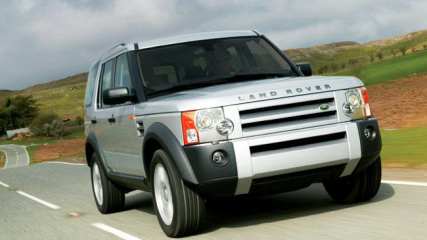
Best 4WD 2009 Review
Read the article
By Fraser Stronach · 21 Jun 2009
Unlike the magazine's 4WD Of The Year award, which only looks at vehicles that are new or significantly revised in that year, these annual accolades look at all the 4WDs on the market. In fact long-time champions dominate these awards but sometimes even long-time champs are forced to step aside. Best Value for Money




